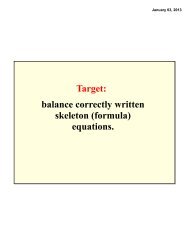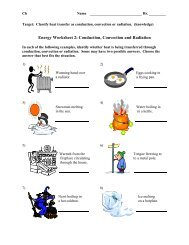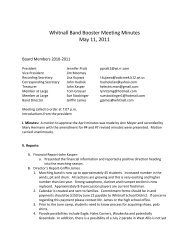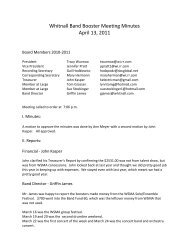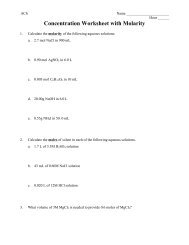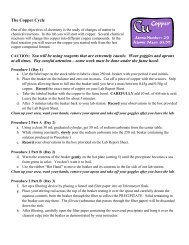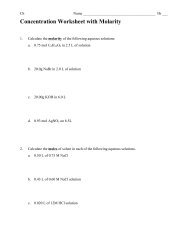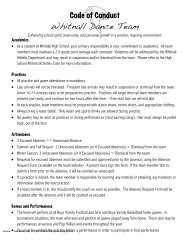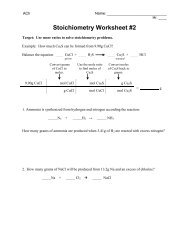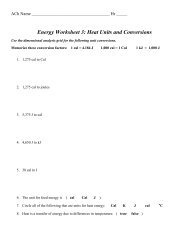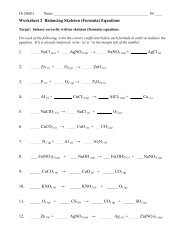2_ waves final review key.pdf - Whitnall High School
2_ waves final review key.pdf - Whitnall High School
2_ waves final review key.pdf - Whitnall High School
You also want an ePaper? Increase the reach of your titles
YUMPU automatically turns print PDFs into web optimized ePapers that Google loves.
Waves Unit ReviewTerms/definitions:1. How are mechanical <strong>waves</strong> different from electromagnetic <strong>waves</strong>?Mechanical <strong>waves</strong> require a mediumGive 3 examples of each.Mechanical: sound, water <strong>waves</strong>, earthquakes, etc.Electromagnetic: visible light, ultraviolet, radio <strong>waves</strong>, etc.2. How are transverse <strong>waves</strong> different from longitudinal <strong>waves</strong>?Transverse – medium is displaced perpendicular to the wave.Longitudinal – medium is displaced parallel to the wave.Give 2 examples of each.Transverse – any form of light, slinky pulse moving side to side.Longitudinal – sound, slinky pulse pushed back and forth3. Know each of these terms/parts of a wave:a. wavelength – distance between adjacent crests or troughsb. frequency – how frequently a wave passes by a certain pointc. period – time for 1 complete oscillation of a waved. amplitude – height of a wave; determined by the energy of the wavee. crest – maximum displacement of a wave in the positive directionf. trough – maximum displacement of a wave in the negative directioni. medium – material through which the wave is traveling (does NOT travel with the wave)4. What is reflection?When a wave bounces off of a barrier or new medium.5. If the frequency of a wave is doubled and the velocity stays the same, what happens to thewavelength?The wavelength will be halved. (They are inversely proportional.)What is the formula for this relationship?v = f · λ6. A particle in a standing wave that does not move is called the node7. The particle of a standing wave that has the most displacement is called the antinode
8. What happens when two <strong>waves</strong> meet?They pass through each other and their amplitudes are added together.What is the law for this behavior called? Law of Superposition.What is the difference between constructive and destructive interference?Constructive – <strong>waves</strong> are in-phase and amplitudes build on top of each otherDestructive – <strong>waves</strong> are out-of-phase and amplitudes cancel each other out9. What is the period of a wave with a frequency of 25 Hz?T = 1/fT = 1/25 = 0.04 s10. The distance between a compression and an adjacent rarefaction is ½ λ11. When two <strong>waves</strong> moving in opposite directions have the exact same frequency andwavelength, they do not appear to be traveling. This type of wave is called a(n)a. surface wave b. torsional wavec. standing wave d. electromagnetic wave12. Which of these parts of a wave is related to the energy of the wave? amplitude13. The bending of a wave as it propagates from one medium to another is calledrefraction .14. Sound <strong>waves</strong> travel through air at a velocity of 340 m/s. What is the frequency of a soundwave that is 0.015m in length?v = f · λ340 = f (0.015)f = 23,000 Hz15. A lifeguard gets really bored and counts the number of <strong>waves</strong> that travel by. In 60 seconds,45 wave crests go past. If each wave is 2.4m in length, how fast are the <strong>waves</strong> traveling?f = 45 <strong>waves</strong>/60 s = 0.75 Hzv = f · λv = 0.75 (2.4)v = 1.8 m/s16. WKTI broadcasts on a frequency of 94.5 megahertz. What is the wavelength of the radiowave?v = f · λ3.0 x 10 8 = 94.5 x 10 6 λλ = 3.17 m



